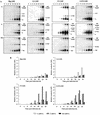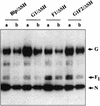Recombinant respiratory syncytial virus with the G and F genes shifted to the promoter-proximal positions
- PMID: 12414935
- PMCID: PMC136893
- DOI: 10.1128/jvi.76.23.11931-11942.2002
Recombinant respiratory syncytial virus with the G and F genes shifted to the promoter-proximal positions
Abstract
The genome of human respiratory syncytial virus (RSV) encodes 10 mRNAs and 11 proteins in the order 3'-NS1-NS2-N-P-M-SH-G-F-M2-1/M2-2-L-5'. The G and F glycoproteins are the major RSV neutralization and protective antigens. It seems likely that a high level of expression of G and F would be desirable for a live RSV vaccine. For mononegaviruses, the gene order is a major factor controlling the level of mRNA and protein expression due to the polar gradient of sequential transcription. In order to increase the expression of G and F, recombinant RSVs based on strain A2 were constructed in which the G or F gene was shifted from the sixth or seventh position (in a genome lacking the SH gene), respectively, to the first position (rRSV-G1/DeltaSH and rRSV-F1/DeltaSH, respectively). Another virus was made in which G and F were shifted together to the first and second positions, respectively (rRSV-G1F2/DeltaSH). Shifting one or two genes to the promoter-proximal position resulted in increased mRNA and protein expression of the shifted genes, with G and F expression increased up to 2.4-and 7.8-fold, respectively, at the mRNA level and approximately 2.5-fold at the protein level, compared to the parental virus. Interestingly, the transcription of downstream genes was not greatly affected even though shifting G or F, or G and F together, had the consequence of moving the block of genes NS1-NS2-N-P-M-(G) one or two positions further from the promoter. The efficiency of replication of the gene shift viruses in vitro was increased up to 10-fold. However, their efficiency of replication in the lower respiratory tracts of mice was statistically indistinguishable from that of the parental virus. In the upper respiratory tract, replication was slightly reduced on some days for viruses in which G was in the first position. The magnitude of the G-specific antibody response to the gene shift viruses was similar to that to the parental virus, whereas the F-specific response was increased up to fourfold, although this was not reflected in an increase of the neutralizing activity. Thus, shifting the G and F genes to the promoter-proximal position increased virus replication in vitro, had little effect on replication in the mouse, and increased the antigen-specific immunogenicity of the virus beyond that of parental RSV.
Figures






Similar articles
-
Effects of altering the transcription termination signals of respiratory syncytial virus on viral gene expression and growth in vitro and in vivo.J Virol. 2004 Jan;78(2):692-9. doi: 10.1128/jvi.78.2.692-699.2004. J Virol. 2004. PMID: 14694100 Free PMC article.
-
Recombinant respiratory syncytial virus from which the entire SH gene has been deleted grows efficiently in cell culture and exhibits site-specific attenuation in the respiratory tract of the mouse.J Virol. 1997 Dec;71(12):8973-82. doi: 10.1128/JVI.71.12.8973-8982.1997. J Virol. 1997. PMID: 9371553 Free PMC article.
-
Recombinant bovine/human parainfluenza virus type 3 (B/HPIV3) expressing the respiratory syncytial virus (RSV) G and F proteins can be used to achieve simultaneous mucosal immunization against RSV and HPIV3.J Virol. 2001 May;75(10):4594-603. doi: 10.1128/JVI.75.10.4594-4603.2001. J Virol. 2001. PMID: 11312329 Free PMC article.
-
Evaluation of the Safety and Immune Efficacy of Recombinant Human Respiratory Syncytial Virus Strain Long Live Attenuated Vaccine Candidates.Virol Sin. 2021 Aug;36(4):706-720. doi: 10.1007/s12250-021-00345-3. Epub 2021 Feb 9. Virol Sin. 2021. PMID: 33559831 Free PMC article. Review.
-
Unravelling the complexities of respiratory syncytial virus RNA synthesis.J Gen Virol. 2006 Jul;87(Pt 7):1805-1821. doi: 10.1099/vir.0.81786-0. J Gen Virol. 2006. PMID: 16760383 Review.
Cited by
-
Examining intra-host genetic variation of RSV by short read high-throughput sequencing.bioRxiv [Preprint]. 2024 Sep 3:2023.05.17.541198. doi: 10.1101/2023.05.17.541198. bioRxiv. 2024. PMID: 39282457 Free PMC article. Preprint.
-
Generation of a More Immunogenic Measles Vaccine by Increasing Its Hemagglutinin Expression.J Virol. 2016 May 12;90(11):5270-5279. doi: 10.1128/JVI.00348-16. Print 2016 Jun 1. J Virol. 2016. PMID: 26984727 Free PMC article.
-
Avian metapneumovirus: A five-plex digital droplet RT-PCR method for identification of subgroups A, B, C, and D.Front Vet Sci. 2022 Nov 15;9:1058294. doi: 10.3389/fvets.2022.1058294. eCollection 2022. Front Vet Sci. 2022. PMID: 36458056 Free PMC article.
-
Recombinant viral hemorrhagic septicemia virus with rearranged genomes as vaccine vectors to protect against lethal betanodavirus infection.Front Immunol. 2023 Mar 14;14:1138961. doi: 10.3389/fimmu.2023.1138961. eCollection 2023. Front Immunol. 2023. PMID: 36999033 Free PMC article.
-
Modeling nonsegmented negative-strand RNA virus (NNSV) transcription with ejective polymerase collisions and biased diffusion.Front Mol Biosci. 2023 Jan 9;9:1095193. doi: 10.3389/fmolb.2022.1095193. eCollection 2022. Front Mol Biosci. 2023. PMID: 36699700 Free PMC article.
References
Publication types
MeSH terms
Substances
Grants and funding
LinkOut - more resources
Full Text Sources
Other Literature Sources

